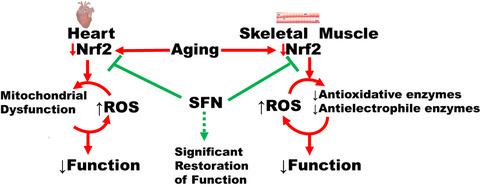当前位置:
X-MOL 学术
›
Aging Cell
›
论文详情
Our official English website, www.x-mol.net, welcomes your feedback! (Note: you will need to create a separate account there.)
Sulforaphane prevents age‐associated cardiac and muscular dysfunction through Nrf2 signaling
Aging Cell ( IF 7.8 ) Pub Date : 2020-10-17 , DOI: 10.1111/acel.13261 Chhanda Bose 1 , Ines Alves 2, 3 , Preeti Singh 4 , Philip T Palade 4 , Eugenia Carvalho 2, 3, 5 , Elisabet Børsheim 2, 5, 6 , Se-Ran Jun 7 , Amrita Cheema 8 , Marjan Boerma 9 , Sanjay Awasthi 1 , Sharda P Singh 1
Aging Cell ( IF 7.8 ) Pub Date : 2020-10-17 , DOI: 10.1111/acel.13261 Chhanda Bose 1 , Ines Alves 2, 3 , Preeti Singh 4 , Philip T Palade 4 , Eugenia Carvalho 2, 3, 5 , Elisabet Børsheim 2, 5, 6 , Se-Ran Jun 7 , Amrita Cheema 8 , Marjan Boerma 9 , Sanjay Awasthi 1 , Sharda P Singh 1
Affiliation

|
Age‐associated mitochondrial dysfunction and oxidative damage are primary causes for multiple health problems including sarcopenia and cardiovascular disease (CVD). Though the role of Nrf2, a transcription factor that regulates cytoprotective gene expression, in myopathy remains poorly defined, it has shown beneficial properties in both sarcopenia and CVD. Sulforaphane (SFN), a natural compound Nrf2‐related activator of cytoprotective genes, provides protection in several disease states including CVD and is in various stages of clinical trials, from cancer prevention to reducing insulin resistance. This study aimed to determine whether SFN may prevent age‐related loss of function in the heart and skeletal muscle. Cohorts of 2‐month‐old and 21‐ to 22‐month‐old mice were administered regular rodent diet or diet supplemented with SFN for 12 weeks. At the completion of the study, skeletal muscle and heart function, mitochondrial function, and Nrf2 activity were measured. Our studies revealed a significant drop in Nrf2 activity and mitochondrial functions, together with a loss of skeletal muscle and cardiac function in the old control mice compared to the younger age group. In the old mice, SFN restored Nrf2 activity, mitochondrial function, cardiac function, exercise capacity, glucose tolerance, and activation/differentiation of skeletal muscle satellite cells. Our results suggest that the age‐associated decline in Nrf2 signaling activity and the associated mitochondrial dysfunction might be implicated in the development of age‐related disease processes. Therefore, the restoration of Nrf2 activity and endogenous cytoprotective mechanisms by SFN may be a safe and effective strategy to protect against muscle and heart dysfunction due to aging.
中文翻译:

萝卜硫素通过 Nrf2 信号传导预防与年龄相关的心脏和肌肉功能障碍
年龄相关的线粒体功能障碍和氧化损伤是导致肌肉减少症和心血管疾病 (CVD) 等多种健康问题的主要原因。尽管 Nrf2(一种调节细胞保护基因表达的转录因子)在肌病中的作用仍未明确,但它已在肌肉减少症和 CVD 中显示出有益的特性。萝卜硫素 (SFN) 是一种天然化合物 Nrf2 相关细胞保护基因激活剂,可为包括 CVD 在内的多种疾病提供保护,并处于临床试验的各个阶段,从癌症预防到降低胰岛素抵抗。本研究旨在确定 SFN 是否可以预防与年龄相关的心脏和骨骼肌功能丧失。2 个月大和 21 至 22 个月大的小鼠队列接受常规啮齿动物饮食或补充 SFN 的饮食,持续 12 周。在研究完成时,测量骨骼肌和心脏功能、线粒体功能和 Nrf2 活性。我们的研究表明,与年轻组相比,老年对照组小鼠的 Nrf2 活性和线粒体功能显着下降,同时骨骼肌和心脏功能也有所下降。在老年小鼠中,SFN 恢复了 Nrf2 活性、线粒体功能、心脏功能、运动能力、葡萄糖耐量和骨骼肌卫星细胞的激活/分化。我们的研究结果表明,与年龄相关的 Nrf2 信号活性下降和相关的线粒体功能障碍可能与年龄相关疾病过程的发展有关。所以,
更新日期:2020-11-23
中文翻译:

萝卜硫素通过 Nrf2 信号传导预防与年龄相关的心脏和肌肉功能障碍
年龄相关的线粒体功能障碍和氧化损伤是导致肌肉减少症和心血管疾病 (CVD) 等多种健康问题的主要原因。尽管 Nrf2(一种调节细胞保护基因表达的转录因子)在肌病中的作用仍未明确,但它已在肌肉减少症和 CVD 中显示出有益的特性。萝卜硫素 (SFN) 是一种天然化合物 Nrf2 相关细胞保护基因激活剂,可为包括 CVD 在内的多种疾病提供保护,并处于临床试验的各个阶段,从癌症预防到降低胰岛素抵抗。本研究旨在确定 SFN 是否可以预防与年龄相关的心脏和骨骼肌功能丧失。2 个月大和 21 至 22 个月大的小鼠队列接受常规啮齿动物饮食或补充 SFN 的饮食,持续 12 周。在研究完成时,测量骨骼肌和心脏功能、线粒体功能和 Nrf2 活性。我们的研究表明,与年轻组相比,老年对照组小鼠的 Nrf2 活性和线粒体功能显着下降,同时骨骼肌和心脏功能也有所下降。在老年小鼠中,SFN 恢复了 Nrf2 活性、线粒体功能、心脏功能、运动能力、葡萄糖耐量和骨骼肌卫星细胞的激活/分化。我们的研究结果表明,与年龄相关的 Nrf2 信号活性下降和相关的线粒体功能障碍可能与年龄相关疾病过程的发展有关。所以,



























 京公网安备 11010802027423号
京公网安备 11010802027423号